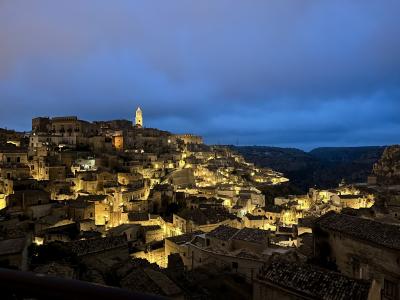Matera's new LED lighting project: 'The Light that Caresses the Stone'

MATERA -- As part of a groundbreaking sustainability project, the historic cave city of Matera in the Basilicata region will soon shine brighter and greener with over 10,000 new LED lights, a press conference in the city heard.
The project, known as “The Light that Caresses the Stone”, is a joint effort from energy company City Green Light, and the Commune of Matera. At the press conference held on the International Day of Light, the project’s aim was described as promoting “sustainability, beauty, and safety.” The panel included Domenico Bennardi, Mayor of Matera, Arturo D’Atri, Business Development Director of City Green Light, and UNESCO architect and urbanist, Pietro Laureano.
During the meeting, it was explained that “This is all-round sustainability, which affects not only the reduction of consumption and light pollution, but also the liveability of the city, the lighting has a very strong impact on the perception of safety, and can make the city more usable during the night.”
Angelo Raffaele Cotugno, the Councillor for Public Works and Innovation described the project as “a complete reconditioning of the city.” The result has been a uniform light colour and a “luminous harmony” which celebrates the beauty of the Sassi di Matera. The most notable buildings of the historic city - the Cathedral, Palazzo Lanfranchi, the Churches of Santa Chiara, San Giovanni Battista, Sant'Agostino, San Francesco, San Biagio, and Purgatorio - will all be fitted with specifically designed architectural lighting systems to accentuate their character further.
Alongside the 10,000 new LED lighting fixtures, the 7 million euro investments also include 66 new traffic lights, 10 km of cable lines, and 108 remote control systems. Designed with sustainability in mind, the new system is powered by 100 per cent green energy, reducing C02 emissions by nearly 1,400 tons per year. Although light pollution is often ignored in big cities, the panel explained how the light fixtures have been designed to fight this, respecting the ambience of the ancient city and allowing residents and tourists alike to appreciate the natural sky of the ancient city.
Mario di Sora, from the International Dark Sky Association, described the project as a national “milestone” for both the reduction of light pollution and notable energy savings, with standards “meeting the most advanced environmental protection regulations.”
The creators of the project equally wanted to ensure inclusivity was also at the heart of their work, with City Green Light installing a network of radio beacons strategically positioned around the city and in urban areas to meet the needs of visually impaired people. Through the use of a talking stick, users will now be able to interact autonomously with the surrounding environment.
Pietro Laureano revealed much of the history of the city and its architecture, which has a longstanding background of sustainability. The lighting system is designed to emphasise these architectural peculiarities. Laureano himself was partly responsible for Matera’s inscription on the UNESCO World Heritage Site list, with Sassi transforming from a dark and abandoned city to one illuminated and inhabited in only 30 years.
“City Green Light’s project interprets the profound sense of Matera: illuminating from its archaic past, the path to the future,” explained Laureano, “It is with great joy today that I see this LED light operation.”
This timeless backdrop has been the set for a variety of films including 007: No Time to Die, Wonder Woman, and Mel Gibson’s The Passion of Christ. Ivan Moliterni, Director of the Ombre Meridiane School in Matera, explained how the city lights can be amplified by the camera, allowing future filmmakers to communicate through the landscape of the city. “Cinema is at the heart of Italian culture, cinema is art, it is creativity.” He summarised.
In Matera’s House of Emerging Technology, Moliterni also inaugurated the exhibition “Rekindling the Imagination: Paths of Light between the Past and Present”, which is free to the public, and highlights the bridge between tradition and technology.
lw

© COPYRIGHT ITALIAN INSIDER
UNAUTHORISED REPRODUCTION FORBIDDEN


